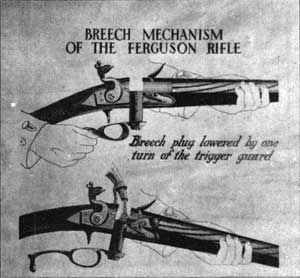
 | ||||||||||
| Intro | Author | Subject | Volume | Volume/Title | NPS | |||||
|
Volume VI - Nos. 1 & 2 |
January-February, 1941 |
|
TESTING THE FERGUSON RIFLE
Modern Marksman Attains High Precision with Arm of 1776 BY ALFRED F. HOPKINS, 
History records that on June 1, 1776, at Woolwich, England, Maj or Patrick Ferguson, of the British Army, demonstrated his newly devised breech-loading flintlock rifle to the astonishment of all beholders. Quite recently at the Washington laboratory of the Museum Division of the National Park Service beholders likewise were astonished at the shooting qualities of the Ferguson gun. While it is understood that tests of this historic arm have been made in England within late years, it is believed that in this country the sinister crack of a Ferguson had not been heard since 1780 at the battle of Kings Mountain, South Carolina. An account of Major Ferguson and his patented breech-loading rifle has been published in The Regional Review1 in connection with information concerning construction of the new museum at Kings Mountain National Military Park. The article provided illustrations of this extremely rare arm, an example of which the Service has been fortunate enough to acquire and which eventually will form a part of the historical exhibit at the museum. Ferguson developed his rifle from two earlier types of breech-loaders, the Hardley and the Foster, upon which it was an improvement; and his gun has the distinction of being the first breech-loading arm used by organized troops of any nation. The piece is equipped with a breech-plug which passes perpendicularly through the breech of the barrel and this, having a quick-traveling screw thread, is lowered or raised by a single revolution of the trigger-guard acting as a lever. When the breech-plug is lowered, a circular opening is left in the top of the barrel just large enough to take a spherical bullet. In loading, the muzzle is held downward and the ball, fitting snugly, is dropped into the opening and permitted to roll forward to the front of the breech-chamber where it is stopped by the lands of the rifling. No wadding or patch is used. Powder and ball rolled to form a cartridge would prove only a hindrance and disadvantage in loading. A charge of powder is poured directly from a flask or horn into the opening behind the bullet, filling the chamber. One complete turn of the trigger-guard causes the breech-plug to rise, closing the opening and ejecting the superfluous grains of powder. When the flash-pan is primed, the piece is ready for firing. In the illustration the breech mechanism and method of loading are shown. Major Ferguson is accredited with loading and firing six shots in one minute. No recent check is known to have been made upon the number of Ferguson rifles now in existence. They undoubtedly do exist but their number in probably small. Apparently only some 200 were made originally and their military use ended, due to lack of foresight, with the American Revolution. Six specimens were listed in 1928 as being in collections in this country and in England2 of which one, probably two, were made by Newton, of Grantham, two by Egg, of London, and one each by Turner and Wilson, of London. These six guns varied somewhat in minor details. A seventh specimen, the one now possessed by the Service at Colonial National Historical Park, Virginia, bears the name of F. Innis, Edinburgh. It is in exceptionally fine condition, showing much of the original metal finish, and is without replacements. The piece measures 4 feet 4 3/4 inches overall and weighs 7-1/2 pounds. The barrel, slightly belled at the muzzle and not designed to carry a bayonet, is 37 inches long, rifled with eight grooves, and takes a ball of .655 caliber. The full-length combed walnut stock is checkered at the grip and has three brass thimbles and an engraved butt plate. On the lock plate forward the hammer, within a scroll, is the name F. INNIS, and this, with the addition of EDINBURGH, together with the proof mark and the view mark of the Gunmakers' Company of London, appears upon the barrel. The wooden ram-rod. is horn-tipped and at the other end has a bullet worm enclosed within a screw cap. The arm was intended for an officer. The recent tests conducted indoors at the Ford's Theater Laboratory were made to determine the exact method of loading the arm, about which there had been some question, and to learn something of its shooting qualities. Loading was found to be extremely easy, suggesting that with practice the record set by Major Ferguson might be attained readily. The ball, weighing approximately 500 grains, was dropped, without patch or wad, into the breech chamber. A charge of approximately one and one-half drams of Dupont "Fg" black powder was poured in behind it. Closure of the breech automatically gauged the charge, superfluous grains being ejected. The same powder, more finely ground, was used as priming. Several preliminary shots indicated that the rifle had precision and accuracy. Then, at a distance of 90 feet, three shots were fired in succession from a table rest by an expert marksman. Number one came within a half-inch, number two came within 4 inches, and number three within 1 3/4 inches of a 1 5/8-inch bull's-eye. 1Dr. C. P. Russell, "The American Rifle at the Battle of Kings Mountain. Vol. 5, No. 1, July, 1940, pp. 16-21. 2John Metschl, "Rudolf J. Nunnumacher Collection of Projectile Arms", Milwaukee Public Museum Bulletin, Vol. 9. This article was subsequently reprinted as part of NPS Popular Study Series #12. | |
| <<< Previous | > Contents < | Next >>> | ||
|
http://www.cr.nps.gov/history/online_books/regional_review/vol6-1-2g.htm Date: 04-Jul-2002 | ||||